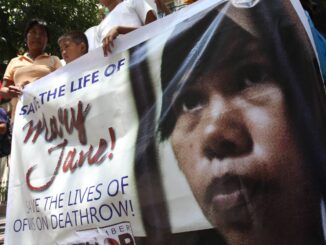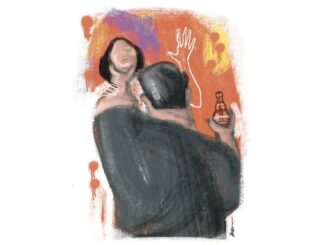
DARAGA, Albay — Dee Jai, an artist from Bicol, quietly observed a group of kids deeply engrossed in their artwork, oblivious to the thick mud and puddles of murky water that surround the makeshift art station in Bulusan, Libon town, in Albay.
As she scanned through the drawings, which mainly featured images of water, dark clouds, lightning and concrete houses rendered in heavy strokes, one artwork caught her attention.
It was a drawing of a colorful flower oozing with childlike charm.
“I asked the kid why she drew a flower, and she said it was because she can’t see flowers anymore with all the mud and floods,” the 39-year-old visual artist said.
In a community heavily devastated when Severe Tropical Storm Kristine (international name: Trami) wreaked havoc in the Bicol Region on Oct. 22, art intervention was used as a means to relieve the trauma of survivors.
At a time when the scent of damp earth lingered in the air and remnants of the disaster — fallen trees, scattered debris and areas submerged in dark sludge — made it difficult to reach this typhoon-stricken village, Dee Jai and the members of the Youth Ambassadors of Albay Province came with food packs and art kits, resolved to bring a ray of sunshine in an otherwise gloomy place.
For her, art is not just something beautiful to behold; it has the power to do much more.
“Art transcends aesthetics and fulfills a deeper purpose. It has the ability to heal individuals and, even more so, to uplift communities,” she said.
Dee Jai’s art relief program in Libon is part of a series of art interventions she plans to conduct under the Tindog Albayano initiative — a relief operation primarily supported by partnerships between private citizens and organizations to aid survivors of Kristine.
As Albay’s provincial art consultant, she has conducted free art workshops for vulnerable groups in the region.
This is the first time, however, that she has brought her program directly to communities ravaged by disasters.
Psychologist Salvacion Laguilles-Villafuerte, chairman of the psychology department of Bicol University, said art interventions could be a good way to cope with trauma, especially for those who need help navigating stressful experiences.
“In distressing circumstances, children show varying cognitive, emotional, and behavioral responses, and using expressive arts as a medium for psychosocial interventions is one of the most effective techniques for children,” Laguilles-Villafuerte said.
She added that writing and drawing activities serve as effective defusing techniques for children who are either directly or indirectly traumatized.
“Expressive arts help the children become engrossed in something they can control — they can put color, design, add or erase details, and write a narrative about their drawings — something opposite of the trauma they experienced, where they felt helpless, voiceless and defenseless. Thus, using art as a psychosocial intervention is quite effective not just for traumatized children but also for adults,” the psychologist said.
For 12-year-old Xian Dave Palivino, one of the children who joined the art intervention in Barangay Masarawag, Guinobatan town, on Oct. 29, the program was a big help.
“Activities like this are great for relieving stress. We felt happy after what happened to us,” he said in the vernacular.
A psychology graduate, Dee Jai also knows how crucial it is to understand the survivors’ thoughts and feelings, even when they can’t fully express them in words, to address their needs.
“These kids experienced the worst in Masarawag, Guinobatan, during Typhoon Kristine, when lahar flows and waist-deep floods left many of their houses in ruins,” she said.
“They barely managed to save anything, so when we arrived, the place was still quite dusty and gloomy. But the moment they saw the art kits, their eyes lit up.” The artist also recalled overhearing a conversation between two kids as they drew scenes of the recent disaster.
“After glancing at a little girl’s drawing of a flooded street, a young boy sitting beside her said, ‘Think positive.’ So the girl added a sun,” she said.
It is stories like this that motivate Dee Jai to continue her mission.
“I realized that every little thing matters for typhoon survivors. Every action, no matter how small, can make a difference in their lives,” she said.
With her slim figure and steady gait, it is difficult to imagine that this mother of four underwent a costly heart procedure in 2021 when she was diagnosed with right ventricular outflow tract (RVOT) arrhythmia.
But it was this seemingly distressing phase in her life that became the turning point in her advocacy to harness the transformative power of art.





Be the first to comment